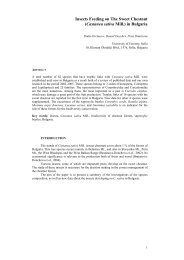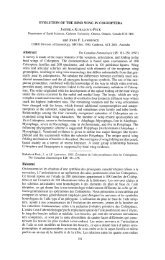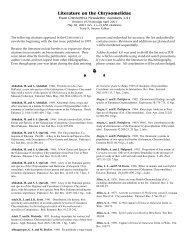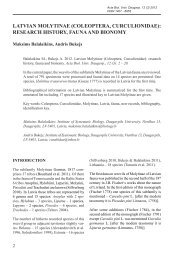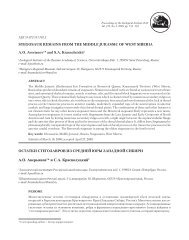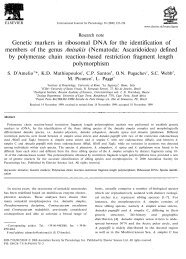Revision of the genus Mniophila STEPHENS, 1831
Revision of the genus Mniophila STEPHENS, 1831
Revision of the genus Mniophila STEPHENS, 1831
Create successful ePaper yourself
Turn your PDF publications into a flip-book with our unique Google optimized e-Paper software.
126 NADEIN, K. S.: <strong>Revision</strong> <strong>of</strong> <strong>the</strong> <strong>genus</strong> <strong>Mniophila</strong> <strong>STEPHENS</strong>, <strong>1831</strong>Fig. 7: <strong>Mniophila</strong> transcaucasica sp. n.: A – body outline, male; B – pronotum outline; C – metasternum;D – antenna; E – head; F – hind tibia <strong>of</strong> male; G – fore tibia <strong>of</strong> male; H – hind tarsus <strong>of</strong> male; I – fore tarsus<strong>of</strong> male; J – aedeagus, ventral view; K – aedeagus, lateral view. Scale bar: A – 1 mm, B-K – 0.5 mm.Description:Body brown to dark-brown with weak bronze luster or without one; legs reddish-brownish. Bodynearly elongated to clearly rounded. Head large, short; vertex covered with well developed, largeshagrination; frontal calli almost not convex; supracallinal sulci poorly visible; frontal ridge short,weakly convex; eyes flattened. Antennae with segments short and thick. Pronotum short, widelytransversal, with very widely rounded base, its surface usually covered with well developed, largeshagrination; punctures large, sparse, poorly visible. Elytra impunctate to well developed, densepunctation, punctures not large; striae partly confused, secondary punctation well developed.Notch between metathoracic cavities straight (Fig. 7C). Legs not very thick, tibiae moderatelycurved; metafemora wide; first protarsomere <strong>of</strong> male wide and thick. Aedeagus (Fig. 7J, K)ventrally with apical third gradually narrowed to apex; apex obtuse with well developed denticle;from lateral view nearly gradually curved from basal third, weakly and gradually narrowed towardapex.Body length – 1.34-1.47 mm, width – 0.91-1.05 mm.Differential diagnosis:From M. caucasica sp. n. differs: in structure <strong>of</strong> aedeagus (Fig. 7J, K), ventrally with apical thirdgradually narrowed to apex; apex obtuse instead <strong>of</strong> aedeagus ventrally with apical 1/4 more or less




